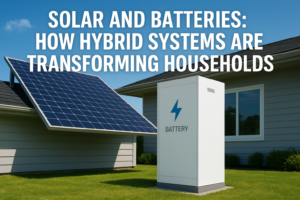Solar and Batteries: How Hybrid Systems are Transforming Households in 2025
Solar and Batteries: How Hybrid Systems are Transforming Households is one of the most exciting developments in renewable energy. Families around the world are realizing that solar panels alone are not enough pairing them with battery storage systems creates a reliable and cost-efficient power source.
These hybrid systems are not only cutting down electricity bills but also ensuring energy security during outages. In 2025, with rising electricity costs and increased focus on sustainability, solar and battery hybrid systems are fast becoming the preferred choice for homeowners.
What Are Solar and Battery Hybrid Systems?
A solar and battery hybrid setup blends solar panels, which generate electricity from sunlight, with a battery system that stores the unused power for later.
Unlike traditional solar installations that supply electricity only during daylight hours, hybrid systems give homeowners the ability to:
- Use solar energy during the day
- Store excess power in a battery
- Use stored power at night or during outages
For a technical guide, check the U.S. Department of Energy.
Why Households Are Switching to Hybrid Solar Solutions
Households are switching to hybrid systems for three main reasons:
Rising Energy Bills – With electricity rates increasing year after year, solar and batteries help households reduce dependence on the grid.
Unreliable Grid Power – In regions with frequent outages, stored battery energy ensures uninterrupted supply.
Eco-Conscious Living – Many families want to lower their carbon footprint and embrace sustainable energy solutions.

Benefits of Solar and Batteries in Daily Life
Lower Electricity Bills
With hybrid systems, homeowners can save 50–80% on electricity bills. Instead of paying for grid power, most of the energy comes from solar panels and stored batteries.
Backup During Power Outages
Unlike traditional solar setups, hybrid systems ensure continuous electricity. Essential appliances like lights, fans, refrigerators, and even Wi-Fi routers stay powered during outages.
Eco-Friendly Energy Choice
Switching to solar and batteries reduces dependence on fossil fuels and contributes to fighting climate change.
How Hybrid Systems Work: A Simple Breakdown
The process is simple yet highly efficient:
- Daytime – Solar panels generate electricity.
- Immediate Use – Energy powers household appliances.
- Excess Energy – Stored in the battery for later.
- Nighttime / Outage – Battery energy powers the home.
This cycle ensures that families have round-the-clock electricity without relying heavily on the grid.
Cost and Return on Investment (ROI) of Solar + Battery Systems
One concern homeowners have is cost. But when you look at the long-term savings, the investment is worth it.
- Average cost (India, 2025): ₹4–6 lakh for a mid-sized system.
- Monthly savings: 50–80% on bills.
- Payback period: 5–7 years.
- Subsidies available: Check MNRE India for government incentives.
Over the system’s 20–25 year lifespan, families can save lakhs in energy bills.
Challenges and Things to Consider Before Installation
Before installing a hybrid solar system, households should evaluate:
- Roof space and direction – Solar panels require proper sunlight exposure.
- Battery capacity – Larger households need bigger storage.
- Budget – Initial setup is expensive, though ROI balances it out.
- Installer expertise – Choose certified solar companies for safety and performance.
Smart Homes and Hybrid Energy Integration
Another advantage of solar and battery hybrid systems is how well they integrate with modern smart home technology. Many households now use smart meters, IoT devices, and home automation systems. When combined with solar and battery storage, these technologies allow homeowners to track real-time energy usage, schedule battery charging, and even sell excess power back to the grid. This level of control ensures maximum efficiency and savings.
Environmental Impact of Solar and Batteries
Apart from cost benefits, hybrid systems play a major role in reducing greenhouse gas emissions. A household running on solar and batteries instead of fossil-fuel electricity prevents tons of carbon dioxide from entering the atmosphere each year. On a global scale, widespread adoption could drastically cut carbon footprints and help countries meet climate change goals. For eco-conscious families, this is one of the strongest reasons to switch.
Future of Solar and Battery Hybrid Systems
The future looks promising. With falling battery costs and advancements in lithium-ion technology, hybrid systems are becoming more affordable.
Governments across the globe are also providing incentives for homeowners, making renewable energy adoption much easier. By 2030, it’s expected that hybrid solar systems will be standard in most new homes, reducing reliance on grid electricity and pushing the world closer to energy independence.
Solar and Batteries: How Hybrid Systems are Transforming Households is more than a trend it’s a revolution in the way we use energy. By combining solar power with battery storage, families enjoy:
- Lower bills
- Reliable power supply
- Eco-friendly living
If you’re considering switching to renewable energy, a solar and battery hybrid system is the best long-term investment for your home in 2025.


 Previous Post
Previous Post